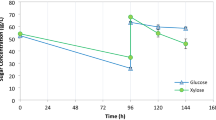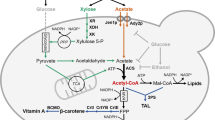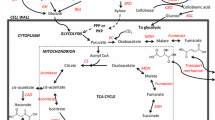Abstract
The concept of transforming renewable plant biomass, and in particular organic waste, to fuels or chemicals continues to attract attention as nonrenewable fossil fuel reserves decrease1,2. Cellulose and hemicellulose, which comprise more than 70% of plant biomass and are the two most abundant organic compounds in the biosphere, occur in the wastes from agriculture and forestry as well as from vegetable and fruit processing and municipal waste treatment. Recycling of these wastes to useful products helps to prevent pollution. After enzymatic or acid hydrolysis, plant biomass yields mostly cellobiose, xylose and glucose together with mannose, galactose and arabinose. Microorganisms which can ferment such a wide range of sugars, at high concentrations, into a high concentration of ethanol have not been reported previously. Here we report on a novel fungus, Paecilomyces sp. NF1, which is capable of fermenting all of the major sugars derived from hydrolysis of plant biomass to ethanol. In xylose fermentation, the ethanol yield of this fungus remained almost unchanged when the concentration of xylose was increased from 20 to 200 g l−1. The fungus also produced good yields of ethanol from glucose, fructose, cellobiose, arabinose, galactose, mannose and ribose, as well as from the simultaneous saccharification and fermentation (SSF) of cellulose with hemicellulose, and from acid hydrolysates of plant biomass.
Similar content being viewed by others
References
Hammond, A. L. Science 195, 564–567 (1977).
Lubinska, A. Nature 314, 395 (1985).
Barron, G. L. Meth. Microbiol. 4, 405–427 (1971).
Takasawa, S., Morikawa, Y., Takayama, K. & Masunaga, I. US Patent no. 4472501 (1984).
Kurtzman, C. P., Bothast, R. J. & Van Cauwenberge, J. E. US Patent 4359534 (1982).
Jeffries, T. W. Biotechnol. Lett. 3, 213–218 (1981).
Fein, J. E., Tallim, R. & Lawford, R. Can. J. Microbiol. 30, 682–690 (1984).
Gong, C. S., McCracken, L. D. & Tsao, G. T. Biotechnol. Lett. 3, 245–250 (1981).
du Preez, J. C. & van der Walt, J. P. Biotechno. Lett. 5, 357–362 (1983).
du Preez, J. C., Prior, B. A. & Monteiro, A. M. T. Appl. microb. Biotechnol. 19, 261–266 (1984).
Suihko, M. L. & Enari, T. M. Biotechnol. Lett. 3, 723–728 (1981).
Margaritis, A. & Bajpai, P. Appl. envir. Microbiol. 44, 1039–1041 (1982).
Schnider, H., Maleszka, R., Wang, P. Y., Veliky, I. A. & Chan, Y. K. US Patent no. 4477569 (1984).
Slininger, P. J., Bothast, R. J., Van Cauwenberge, J. E. & Kurtzman, C. P. Biotechnol. Bioengng 24, 371–384 (1982).
Ueng, P. P. & Gong, C. S. Enzyme microb. Technol. 4, 169–171 (1982).
Dekker, R. F. H. Biotechnol. Lett. 4, 411–416 (1982).
Leonard, R. H. & Hajny, G. J. Ind. Engng Chem. analyt. Edn 37, 390–395 (1945).
Lee, Y. Y. & McCaskey, P. A. TAPPI 66, 102–107 (1983).
Author information
Authors and Affiliations
Rights and permissions
About this article
Cite this article
Wu, J., Lastick, S. & Updegraff, D. Ethanol production from sugars derived from plant biomass by a novel fungus. Nature 321, 887–888 (1986). https://doi.org/10.1038/321887a0
Received:
Accepted:
Issue Date:
DOI: https://doi.org/10.1038/321887a0
- Springer Nature Limited
This article is cited by
-
Isolation and Characterization of Zygomycetes Fungi from Tempe for Ethanol Production and Biomass Applications
Applied Biochemistry and Biotechnology (2012)
-
Towards industrial pentose-fermenting yeast strains
Applied Microbiology and Biotechnology (2007)
-
Ethanol fermentation from biomass resources: current state and prospects
Applied Microbiology and Biotechnology (2006)
-
Screening forl-arabinose fermenting yeasts
Applied Biochemistry and Biotechnology (1996)
-
Xylose metabolism in a thermophilic mouldMalbranchea pulchella var.sulfurea TMD-8
Current Microbiology (1994)





